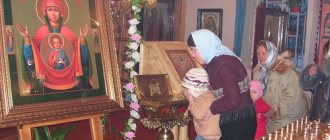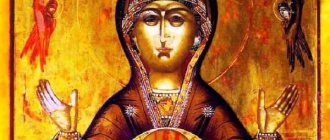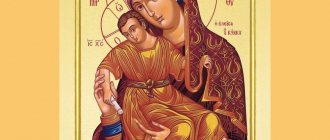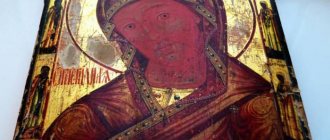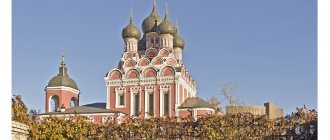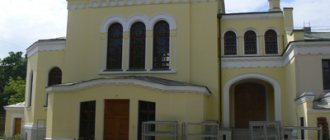Icon of the Mother of God of Lydda (On a pillar in Lydda)
In the city of Lydda (later Diospolis), not far from Jerusalem, where the holy apostles Peter (June 29 and January 16) and John the Theologian (May 8 and September 26) preached the Lord Jesus Christ, a temple was built for the converts in the name of the Most Holy Theotokos. Arriving in Jerusalem, the apostles prayed to the Mother of God to visit and consecrate and bless the temple with Her presence. The Most Pure Virgin said: “Go in peace, there I will be with you.” Returning to the Lydda Church, they saw on one of the supporting pillars a miraculous image of the Most Holy Theotokos of wondrous beauty. Then the Mother of God Herself visited the Lydda Church and bestowed special grace and power on Her image.
During the reign of Emperor Julian the Apostate (361–363), a new miracle occurred in Lydda. Stonemasons were sent to the temple to destroy the miraculous image. However, no matter how hard they tried to chip away at the sacred image, it did not disappear, but only went deeper and deeper into the pillar. The fame of the blessed image spread throughout the world, and numerous believers began to flock to Lydda to venerate the miraculous image of the Mother of God.
In the 8th century, by order of the Patriarch of Constantinople Herman, a copy was made from it, which miraculously ended up in Rome and also received miraculous power (celebration on June 26). This list was named Rimsky.
There was another Lydda miraculous image of the Mother of God. He was in the temple created in Lydda by Aeneas, healed by the holy Apostle Peter (Acts 9:32-35). When Jews and pagans wanted to take this temple away from Christians, by order of the ruler the temple was locked for three days so that a sign would appear to resolve the dispute. When the temple was opened three days later, they saw in it a miraculous image of the Mother of God.
Three eastern Patriarchs (Jerusalem, Antioch and Alexandria) wrote about both miraculous Lydda icons in a letter to the iconoclast emperor Theophilus (829–842). Emperor Constantine Porphyrogenitus (912–959) speaks about this message in his historical discourse on the miraculous image of the Savior in Edessa.
There is an interesting connection between the Lydda Icon of the Mother of God and the history of the appearance in Russia of the Vladimir and Tikhvin images of the Blessed Virgin Mary. In the “Tale of the Meeting of the Vladimir Icon of the Theotokos”, in connection with the thought of Rus' as the inheritance of the Mother of God, the following is said: “You, O Lady Theotokos, are your miraculous image, and many say the Tuesday icon, which was called the Romans in ancient times, at first the Lida call , south... Herman commanded that the self-imagined image be painted in Lida, and for the sake of Leo the Savrian he sent the iconoclasm to Rome, placing it on the sea. And so the holy icon itself came to Rome one night, and after 130 years the icon itself left the Roman Church on the sea and came to the reigning city... in the years... of Rurik, then in our Russian land on the river on Tikhvin, appearing in the air as saints carried by invisible angels, and has remained there to this day, performing countless miracles and generously giving healing to all who come with faith...”
LYDDA (ROMAN) ICON OF THE MOTHER OF GOD
"Roman" icon of the Mother of God. 1668 Fragment. Icon painters Ivan Karpov, Fyodor Karpov Popov, Simon Ushakov, Grigory Zinoviev (Tretyakov Gallery)
"Roman" icon of the Mother of God. 1668 Fragment. Icon painters Ivan Karpov, Fyodor Karpov Popov, Simon Ushakov, Grigory Zinoviev (Tretyakov Gallery)
known from the few Russian monuments, varied in technique and scale. art from the middle XVI century (frescoes, marks of iconographic images, silver pellets). As an independent plot, illustrations for “The Legend...” have appeared in Moscow art since the 60s. XVI century, in the XVII century are found mainly as part of illustrated cycles of legends about the Tikhvin Icon of the Mother of God. The earliest and most complete of the currently known is the cycle of Legends on 22 silver niello pellets on a shroud of the 18th century. to the throne of the Annunciation Cathedral of the Moscow Kremlin (GMMK; Vilkova. 2001. P. 167-175; Faith and Power: The Age of Ivan the Terrible: cat. exhibition M., 2007. P. 126-127). The composition of the plots on the fractions indicates that when they were created, the most complete edition of the “Tale of ...” was used, expanded by the Life of Patriarch Herman of K-polsky and the content of the “Message of the Three Eastern Patriarchs to Emperor Theophilus” (the earliest manuscript of the “Message ...” dates back to 9th century; see: The Miraculous Icon. pp. 421-435), including a collection of short stories about Byzantine miraculous images, in particular about the 2 Images of the Mother of God not made by hands, revealed in the city of Lydda. That. overlapping plots appeared: the discovery of the Image of the Mother of God not made by hands on the pillar of the temple and the appearance of the Image of the Mother of God not made by hands in the temple built by Aeneas. As a result of repeated alterations, the sequence of the pellets on the shroud from the Annunciation Cathedral was disrupted. However, order can be restored thanks to, for example, the “Roman Icon of the Mother of God” from c. St. Gregory of Neocaesarea in Moscow, the work of icon painters Ivan Karpov, Fyodor Karpov Popov, Georgy Zinoviev and Simon Ushakov (1668, Tretyakov Gallery; see: Chinyakova. 2009), where 24 scenes of “The Legend...” are placed sequentially: 1. Caress of the Most Holy. Mother of God; 2. Prayer to the Most Rev. Our Lady of the Mount of Olives; 3. The discovery of the Holy Image of the Most Holy One on a pillar in the temple of Lydda. Mother of God; 4. Debate between Aeneas and the Jews about the dedication of a new temple; 5. Evangelist Luke’s writing of the image of the Mother of God; 6. Finding the Miraculous Image of the Mother of God in the temple built by Aeneas; 7. Rev. The Mother of God indicates the place for the temple; 8. Prayer of Patriarch Herman before the Icon of the Mother of God Not Made by Hands in Lydda; 9. Writing a list on a pillar with a miraculous image for Patriarch Herman; 10. Imp. Anastasius asks Herman to become patriarch; 11. Patriarch Herman forbids Leo the Isaurian to fight with icons; 12. Deposition of Patriarch Herman by Leo the Isaurian; 13. Vision of the image of St. The Virgin Mary in a dream to Pope Gregory; 14. Meeting the image of St. Our Lady of Rome; 15. Return of Pope Gregory to Rome with the found icon of the Mother of God; 16. Worship Rom. ambassadors of the icon of the Mother of God found in K-pol; 17. Installation of the image of St. Virgin Mary in the Cathedral of the Apostles Peter and Paul; 18. A sign in the Cathedral of the Apostles Peter and Paul about the imminent departure from Rome of the miraculous image; 19. Exodus of the miraculous image from Rome; 20. Meeting of the Roman icon of the Mother of God in K-field; 21. Prayer to the Emperor. Theodora in front of the found image of the Mother of God; 22. Placement of the icon in the Chalcopratia temple of K-field.
The Legend of the Lydda Icon of the Mother of God. Painting of the Intercession (Trinity) Cathedral of Alexandrova Sloboda. 60s XVI century (recorded in the 19th century)
The Legend of the Lydda Icon of the Mother of God. Painting of the Intercession (Trinity) Cathedral of Alexandrova Sloboda. 60s XVI century (recorded in the 19th century)
The next most recent facial iconographic “Tale...” are the marks of the icon “Our Lady of Lidda (Roman), with a facial legend about history and miracles” (1587, GMZRK). The center of the icon is surrounded by 15 hallmarks, the plots and iconographic schemes of 11 coincide with the images on the 16th-century gravestones. Moscow Kremlin veil. Illustrations for 10 scenes from “The Legend…” contain 7 of the 24 stamps of the Smolensk Icon of the Mother of God from the Annunciation Cathedral of the Moscow Kremlin (last quarter of the 16th century, GMMC); iconography of L. and. on this image is unusual: the image of the Mother of God belongs to the “Tenderness” type. The compositional schemes of 16 scenes on 4-row doors of “The Miracles of the Roman Icon of the Mother of God” (1602, Tretyakov Gallery (P. D. Korin Museum)) largely follow the silver beads on the shroud from the Annunciation Cathedral of the Kremlin. It is possible that the iconographic prototype for all these monuments was the unpreserved illuminated manuscript of the 2nd half. XVI century (Samoilova. 2007. P. 13).
Since the 17th century L. and. is finally identified with the Tikhvin Icon of the Mother of God (Kvlividze. 2003. P. 228) and individual plots of the “Tale...” are included in the hallmarks of the Tikhvin Icon. For example, on the Tikhvin Icon of the Mother of God with 103 hallmarks from the Assumption Cathedral of the Moscow Kremlin (1668, GMMK), hallmarks 66-91 are dedicated to the illustration “Tales ...” about L. and .; on the Tikhvin Icon of the Mother of God from c. The Mother of God “Hodegetria” on the Sands in Kaluga (1680, TsMiAR) in stamp 18 presents the prehistory of the Tikhvin image, originating from L. and., in another interpretation, which does not literally illustrate the “Legend...” (Ivanova. 1966. P. 429- 430). Two scenes from “The Legend…” are included in the stamps of the Yaroslavl Icon of the Mother of God from c. St. John Chrysostom in Korovniki (80s of the 17th century, YAHM).
In fresco painting, the earliest illustrations are in the paintings of the Intercession Cathedral of the Alexander Sloboda (60s of the 16th century; 17 scenes) and the murals of the Smolensk Cathedral of the Novodevichy Monastery (lower tier of the northern and western walls; 8 scenes grouped into 4 compositions, including the painting by Evangelist Luke of the icon of the Mother of God; the discovery of the Image of the Mother of God not made by hands on a pillar in the city of Lydda; the writing of a copy of the Image not made by hands commissioned by Patriarch Herman, etc.). Researchers associate the appearance of these subjects in the paintings of the Smolensk Cathedral with the time of Boris Feodorovich Godunov, during whose reign the religious-state theme was relevant. the idea of “Moscow is the third Rome”, formulated back in the 20s of the 16th century. The legend about the icon that visited Rome, left K-pol and moved to the “third Rome” - the Moscow kingdom, was an excellent illustration of these theories (Ibid. pp. 222-235). The paintings of the Intercession Cathedral of the Alexander Sloboda, the Smolensk Cathedral of the Novodevichy Convent and the plot of the 1587 icon from Rostov reveal similarities in the choice of episodes and iconography of scenes (Kvlividze. 2003. P. 232). A similar cycle of compositions illustrating the Legend of L. and. is also contained in the paintings of the Annunciation Cathedral in Solvychegodsk (1600) (Chinyakova. 2009. P. 20).
M. V. Vilkova
Lists of the Lydda Icon Not Made by Hands in Russia
One of the editions of the Lydda image of the Blessed Virgin Mary was kept in the Boris and Gleb Monastery (Rostov diocese) before the coup of 1918.
It is almost 18 km from Rostov Veliky. In 1588, it was brought to the monastery by Elder Valaam, who was the builder of the temple. The copy contains an inscription stating that this is a copy of the icon, which was independently depicted on a church pillar in the temple built by the apostles of Christ. During the difficult years of hard times, the holy miraculous relic of the Boris and Gleb Monastery was violated by removing its precious covering - the chasuble. A little later, the monastery itself was closed, and the icon was taken away. Further traces of the valuable list are lost. The Lydda image was transferred (1937) to the State Tretyakov Gallery, but only according to the documentation. In fact, a completely different icon is located and described here.
The creation of a new copy of the Lydda icon of the Blessed Virgin Mary took place in the workshop of the school of icon painting at the Trinity-Sergius Lavra (2001) with the blessing of Archbishop Micah of Rostov and Yaroslavl. The dimensions, composition and colors of the reproduction completely coincide with the first-found Lydda miraculous icon. Despite the reproaches and losses, the Mother of God continues to help those who turn to her, hears everyone, asks for everyone.
Features of the miraculous Lydda Icon of the Mother of God
The image of the Most Pure Virgin Mary with the Child Christ seated on her left hand belongs to the Hodegetria icon painting type. Mary bowed her head to the head of the Son of God. The main feature that distinguishes this image from other Virgin Mary compositions is the position of the hands: the right hand of the Savior and the left hand of the Most Pure One touch each other. It looks as if the Mother of God is trying to cover the hand of the Infant Christ with her hand.
The miraculous icon attracted more and more people to the Christian church, who wanted to see with their own eyes the wonderful Lydda image. And once they saw it, faith in the Lord Jesus Christ was born and grew in their hearts, and the desire to follow the path outlined by him.
Perhaps, of the apostles, not only Luke was an icon painter
– It is generally accepted that the first image of the Mother of God was captured by the Evangelist Luke.
But there are no exact data and documents confirming this? – There is no exact data, because the first mention that the Evangelist Luke was an icon painter dates back to the 8th century AD, this was mentioned by Saint Andrew of Crete. And the Evangelist Luke, as we understand, lived in the 1st century.
Does this prove with any accuracy that the Evangelist Luke was not an icon painter? No, it doesn’t prove it, because it cannot be ruled out that the Evangelist Luke was not only a Greek doctor, but also an artist.
There is no documentary evidence of this. But tradition made him an icon painter. A huge number of icons are associated with his name. According to various estimates, there are about 800 different images in the East and West.
In particular, tradition attributes to Luke the Vladimir image of the Mother of God. True, this legend appears in Russian sources only in the 15th century. Here, too, one can understand the desire of believers to associate the most revered, important images with the most ancient icon painter. Raise these images to the most ancient examples, examples written by the Evangelist Luke himself. And thereby make these examples themselves holy.
What is more important is not that these samples were made specifically by the Evangelist Luke. And the fact is that there were the most ancient prototypes that gave rise to all this variety of types of images of the Virgin Mary with the Child and without the Child, and they refer us to them.
Medieval people, looking at the image of the Mother of God “Oranta” in the altar of the Kyiv Cathedral of Hagia Sophia, quite likely recalled the images of the Blachernae Temple in Constantinople.
Stroganov's copy of the Blachernae Icon of the Mother of God. Tretyakov Gallery
There is an ancient legend that the other apostles were also icon painters.
In particular, there is an Armenian legend that one of the oldest images, if not the most ancient, of the Mother of God was painted by the Apostle John. Moreover, it was written on the tombstone of the Virgin Mary. This icon was kept in one of the Armenian monasteries for centuries.
– An incredibly large number of images of the Mother of God have been written, either 500 or 700. Do they all fit into the canon? When did the canonical image of the Blessed Virgin Mary take shape?
– What do we mean by the word “canon”? If by the word “canon” we mean a certain stable pattern, then this is a late phenomenon.
The culmination of the understanding of the canon as a set of stable schemes took shape in the 18th century, when the vaults of the Mother of God icons appeared.
The vaults of the Mother of God icons are most similar to stamp collections. Usually in the center of such a vault is the main image, chosen at the request of the customer. He is surrounded by many such “stamps” that have a stable iconographic scheme. On one such icon, for example, 120 small images of the Mother of God can be written. Such formalization is a fairly clear sign of an internal crisis in icon painting.
Just like the rigid linking of one or another type of icon to different types of help. Some priests are very fond of explaining that this scheme (this image) helps against drunkenness, another against childbearing, the third against an epidemic...
All these phenomena have little connection with the genuine, ancient Byzantine tradition.
What was in the ancient tradition and how does what we now call the canon appear, namely different types of images of the Mother of God?
Five icons of the Blachernae Temple
Russian Icon with a set of miraculous images of the Mother of God, 19th century
Ancient artists depicted different states - this is the most accurate word - of the Mother of God and highlighted one or another aspect in them.
For example, in the type that we now call “Tenderness,” where the Mother of God presses the baby to her cheek, the deep closeness between the Mother of God and her Son, their closest internal connection, is emphasized.
In the type that we now call the “Sign”, where the Mother of God raises her hands, there is a gesture of intense prayer, which the priest still uses in prayer over the Blessed Sacrament. Liturgical gesture.
In the so-called image of the Mother of God “Paraklisis” (“Prayer”) - in our tradition we often call such an icon the Bogolyubskaya - the icon painter highlighted the moment of the Mother of God’s conversion to Christ.
Some of these images became revered over time and found their place in the most famous temples of the Byzantine Empire. For example, we know that at least five of these important miraculous images of various types were in the Blachernae Church of the Virgin Mary in Constantinople. This was the main temple of Our Lady in the entire Byzantine Empire.
We know for sure that in this temple there was a prototype of what we now call the image of the Mother of God “The Sign” with a medallion on her chest. And also the prototype of the icon that we know as the Vladimir Icon of the Mother of God.
But it cannot be said that there were any sets of schemes, working matrices for images. It’s just that ancient images became revered, and other icon painters created repetitions and replicas of them.
The schemes appeared much later. Researchers of the 19th century studied the existing icon painting schemes and tried to classify them. For example, the great historian of Byzantine art of the 19th century, Nikodim Pavlovich Kondakov, dealt with this a lot. He wrote a classic work in two volumes - “The Iconography of the Mother of God”. But by and large, he didn’t succeed much, because these schemes turn out to be almost endless.
– That is, it cannot be said that we have 3-4 canonical types of images: “Tenderness”, in which the Mother of God hugs the baby, “Oranta” - “The Sign”, in which the Mother of God raises her hands, “Hodegetria” - “Guide” , in which the Infant God holds a scroll in one hand and blesses those praying with the other?
- No. Absolutely. There are many more of them.
Moreover, if we take the so-called “Hodegetria”, then we will see a huge number of options there. The so-called “Aristocratus”, that is, “Left-handed”, and “Dexiocratus”, that is, “Right-handed”. If the position of the Child is one, then in our terminology this icon becomes the “Iveron Icon of the Mother of God”, the other – the “Hodegetria of Constantinople”.
But if we compare the same copies of the Vladimir Icon of the Mother of God, which seem to repeat the basic scheme, for example, the image of Andrei Rublev, with the original - the 12th century icon from the Blachernae Church, we will see a completely different icon, with a different image, with a different meaning.
Iconoclasm against the miraculous image
Almost three hundred years later, during the reign of Julian the Apostate (from 361 to 363), a convinced pagan and opponent of Christianity, the icon of the Mother of God of Lydda again showed a miracle. The ruler sent stonemasons to the Church of the Mother of God, ordering them to destroy the miraculous icon. The masters tried to complete the task - to chip away at the holy image, but it did not disappear. It seemed that the image of the Mother of God was going deep into the stone pillar.
The news of the miraculous power of the icon quickly spread among the Christians of Palestine; they came from all over the country to venerate the holy image of the Queen of Heaven. A copy was made from the found face, which was taken to Rome. This icon showed power and became miraculous.
Miracles of Lydda Images
Today the exact fate and location of the first-discovered Lydda miraculous image of the Mother of God is not known. The latest evidence about him tells of numerous miracles performed in the 11th century.
Saint Germanus (the future Patriarch of Constantinople), who lived in the 8th century, highly valued the miraculous icon of the Mother of God. He headed towards Palestine with the desire to see all the holy, famous places. Arriving in Jerusalem, Herman bowed to the tomb of Jesus Christ, then headed to the holy places of Lydda. Strongly impressed by what he saw, the future patriarch ordered a local icon painter to paint an exact copy of the miraculous icon on the board. With reverence, the pilgrim took her with him to Constantinople. And after that he always kept the image with him and prayed in front of it every day.
With the ascension to the throne of the god-fighting emperor Leo the Isaurian, Herman began to be persecuted. Being in need and exile, the ruler understood that his death was approaching. He wrote a message to Pope Gregory, placed it in an image and set it free on the waves, saying that the Lady (icon) should immediately leave not from Herod to Egypt, but from the enemy with the name of the beast to Rome, “to the pious Christians.” The next day the image stopped at the mouth of the Tiber, reaching Rome. Pope Gregory II had a vision in a dream, announcing the appearance of the image. He went to meet all the servants of the temple, accepted the shrine that was walking on the water, and then installed it in the altar of St. Peter's Cathedral. Soon many pilgrims flocked to the new Roman icon for healing.
After the restoration of the veneration of holy images (842), the Romans paid attention to the repeated fluctuations of the Lydda icon. And suddenly, during a church service, she stood up and, walking over the heads of the parishioners, left the temple and descended onto the waters of the Tiber River. The Romans were afraid that the image had left them as a sign of the wrath of the Almighty. Meanwhile, the icon sailed to Constantinople and stopped not far from the royal chambers, in the harbor. Pious people took her and delivered her to Emperor Michael and Queen Theodora, his mother. The emperor, patriarch, and retinue placed the newly found shrine in the Church of the Virgin Mary (Chalkopratia Square). This is how the Lydda Icon of the Mother of God received the name Roman.
